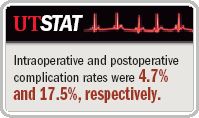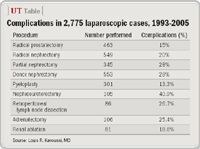Article
Lap complications plateau; volume, experience are keys
New Hyde Park, NY-As difficult as laparoscopic cases in urology are now, the complication rates have not increased, according to a retrospective chart analysis of the complications associated with nearly 3,000 laparoscopic procedures at a high-volume center. The data, compiled over a 12-year period at Johns Hopkins Medical Institutions, Baltimore, were reported at the 2006 AUA annual meeting in Atlanta.

"The good news is that complications plateaued in 2000," said senior author Louis R. Kavoussi, MD, who was cautiously optimistic, emphasizing that the keys to minimizing complications are surgeon volume, hospital volume, and surgeon experience.


Gauging frequency and severity
For all 2,775 laparoscopic procedures, the complication rate was 22%: 614 complications were identified in 525 patients. The total intraoperative complication rate was 4.7%, compared with 17.5% for postoperative complications.
"We used to have a lot of operative injuries and conversions," Dr. Kavoussi said. "Our complication rates have moved from perioperative to postoperative, which is a good sign. Now we need to address early ambulation, anticoagulation, and relate how patients are handled in the post-op setting to patients' illness factors and comorbidities."
Complication rates associated with each procedure were nephrouretorectomy, 40.9%; laparoscopic partial nephrectomy, 28%; retroperitoneal lymph node dissection, 26.7%; adrenalectomy, 25.4%; laparoscopic nephrectomy, 20%; renal ablations, 18.6%; donor nephrectomy, 28%; radical prostatectomy, 15%; and pyeloplasty, 13.3%.
Complications were measured in two ways. The first used the Clavien Classification System, a seven-grade scoring system in which grade I represents the lowest-severity laparoscopic-related complications, grade V represents death, and the range of progressively worsening complications is represented by the grades in between these two extremes. (Grades III and IV each include two subgroups.)
The second method for measuring complications was whether they were minor (requiring little, if any additional treatment, and not requiring hospitalization beyond 2 days) or major (morbidity necessitating additional treatment and requiring at least 2 additional days in the hospital).




